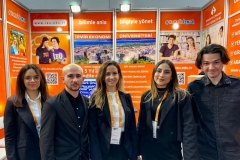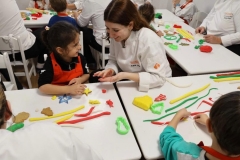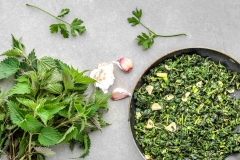
SCHOOL OF APPLIED MANAGEMENT SCIENCES
Gastronomy and Culinary Arts Program
GEAR 213 | Course Introduction and Application Information
| Course Name |
Art Movements and Artists of the 20th Century
|
|
Code
|
Semester
|
Theory
(hour/week) |
Application/Lab
(hour/week) |
Local Credits
|
ECTS
|
|
GEAR 213
|
Fall/Spring
|
3
|
0
|
3
|
4
|
| Prerequisites |
None
|
|||||
| Course Language |
English
|
|||||
| Course Type |
Service Course
|
|||||
| Course Level |
First Cycle
|
|||||
| Mode of Delivery | - | |||||
| Teaching Methods and Techniques of the Course | DiscussionGroup WorkLecture / Presentation | |||||
| Course Coordinator | - | |||||
| Course Lecturer(s) | ||||||
| Assistant(s) | - | |||||
| Course Objectives | The objective of this course is to emphasize a conceptual understanding of art movements in the 20th century. |
| Learning Outcomes |
The students who succeeded in this course;
|
| Course Description | Students will be able to identify different art movements, will gain basic understanding of each work’s possible concept, significance and style and will be able to examine selected art works from the 20th century. |
|
|
Core Courses | |
| Major Area Courses | ||
| Supportive Courses | ||
| Media and Management Skills Courses | ||
| Transferable Skill Courses |
WEEKLY SUBJECTS AND RELATED PREPARATION STUDIES
| Week | Subjects | Related Preparation |
| 1 | Introduction: Brief information about the art journey of humanity. The changing conditions which lay foundation for Modernism. | Weston, R. (1996), Modernism, Phaidon Press, pp: 8-19, video on Industrial Revolution. |
| 2 | Last decades of 19th century. Impressionism, Post Impressionism, Symbolism, Art Nouveau | Kleiner, Fred, et.al, (2004). Gardner’s Art Through the Ages. Thomson Wadsworth, pp. 919-930. |
| 3 | Cubism, Primitivism and Futurism | Kleiner, Fred, et.al, (2004). Gardner’s Art Through the Ages. Thomson Wadsworth, pp. 959-967. |
| 4 | Expressionism, Fauvism | Kleiner, Fred, et.al, (2004). Gardner’s Art Through the Ages. Thomson Wadsworth, pp. 919-930. Buchholz, E.L., Bühler G., Hille K., Kaeppele, S., Stotland I. (2007). Art –The History of Modern Art, Peter Delius Verlag, pp. 415-459 |
| 5 | Bauhaus, Constructivism | Weston, R. (1996), Modernism, Phaidon Press, pp: 119-137; Shiner, L. (2001). The Invention of Art. Chicago, The University of Chicago Press. pp.246-268. |
| 6 | New Experiments: Dada, Suprematism, Neo-Plasticism | Philips, S. (2018) isms: Understanding Modern Art, Herbert Press. Pp.52-56 Buchholz, E.L., Bühler G., Hille K., Kaeppele, S., Stotland I. (2007). Art –The History of Modern Art, Peter Delius Verlag. |
| 7 | Surrealism | Philips, S. (2018) isms: Understanding Modern Art, Herbert Press.pp.64-67 Buchholz, E.L., Bühler G., Hille K., Kaeppele, S., Stotland I. (2007). Art –The History of Modern Art, Peter Delius Verlag. |
| 8 | Midterm | |
| 9 | Realism: Social Realism, Kitchen Sink Realism | Philips, S. (2018) isms: Understanding Modern Art, Herbert Press. |
| 10 | Abstract Expressionism. | Philips, S. (2018) isms: Understanding Modern Art, Herbert Press. Buchholz, E.L., Bühler G., Hille K., Kaeppele, S., Stotland I. (2007). Art –The History of Modern Art, Peter Delius Verlag. |
| 11 | Pop Art, Op Art, Conceptual Art | Buchholz, E.L., Bühler G., Hille K., Kaeppele, S., Stotland I. (2007). Art –The History of Modern Art, Peter Delius Verlag. Adorno, W.T., Culture Industry, Routledge Classics “The Schema of Mass Culture” |
| 12 | Post Modernism. Feminist Art. | Broude, N., Garrard M. D., (1994) The Power of Feminist Art, Thames and Hudson, pp. 10-29. |
| 13 | Live Art: Installation, Performance and Dance | Videos |
| 14 | Environmental art, Technological Art. | Invitation to the Gallery pp.281-285 |
| 15 | Review | |
| 16 | FINAL EXAM |
| Course Notes/Textbooks | Adorno, W.T., Culture Industry, Routledge Classics.
|
| Suggested Readings/Materials | https://www.khanacademy.org/ |
EVALUATION SYSTEM
| Semester Activities | Number | Weigthing |
| Participation |
1
|
10
|
| Laboratory / Application | ||
| Field Work | ||
| Quizzes / Studio Critiques | ||
| Portfolio | ||
| Homework / Assignments |
1
|
10
|
| Presentation / Jury |
1
|
20
|
| Project | ||
| Seminar / Workshop | ||
| Oral Exams | ||
| Midterm |
1
|
30
|
| Final Exam |
1
|
30
|
| Total |
| Weighting of Semester Activities on the Final Grade |
4
|
70
|
| Weighting of End-of-Semester Activities on the Final Grade |
1
|
30
|
| Total |
ECTS / WORKLOAD TABLE
| Semester Activities | Number | Duration (Hours) | Workload |
|---|---|---|---|
| Theoretical Course Hours (Including exam week: 16 x total hours) |
16
|
3
|
48
|
| Laboratory / Application Hours (Including exam week: '.16.' x total hours) |
16
|
0
|
|
| Study Hours Out of Class |
10
|
3
|
30
|
| Field Work |
0
|
||
| Quizzes / Studio Critiques |
0
|
||
| Portfolio |
0
|
||
| Homework / Assignments |
1
|
10
|
10
|
| Presentation / Jury |
1
|
10
|
10
|
| Project |
0
|
||
| Seminar / Workshop |
0
|
||
| Oral Exam |
0
|
||
| Midterms |
1
|
10
|
10
|
| Final Exam |
1
|
15
|
15
|
| Total |
123
|
COURSE LEARNING OUTCOMES AND PROGRAM QUALIFICATIONS RELATIONSHIP
|
#
|
Program Competencies/Outcomes |
* Contribution Level
|
||||
|
1
|
2
|
3
|
4
|
5
|
||
| 1 | Successfully applies theoretical and practical knowledge and skills in Gastronomy and Culinary Arts |
|||||
| 2 | Carries best practices in terms of work and food security, safety and hygiene in food production |
|||||
| 3 | Appreciates, evaluates and makes decisions regarding to visual, textual and nutritional data with respect to food production and presentation |
|||||
| 4 | Recognizes and evaluates the impact of gastronomy on culture and society |
|||||
| 5 | Assumes responsibility for solving complex problems that may occur in the field of Gastronomy and Culinary Arts, both individually and as a team member |
|||||
| 6 | Evaluates the knowledge and skills acquired in the field of Gastronomy and Culinary Arts with a critical approach and effectively communicate their ideas and suggestions for solutions in written and oral form. |
|||||
| 7 | Possesses necessary knowledge and skills in relevant fields such as gastronomy, design, law and management and effectively apply them to the practice of Culinary Arts |
|||||
| 8 | Uses the technological tools related to Gastronomy and Culinary Arts effectively |
|||||
| 9 | Updates and improve the knowledge, skills and competencies related to Gastronomy and Culinary Arts with lifelong learning awareness and sustainability with an ethical approach |
|||||
| 10 | Collects data in the areas of Gastronomy and Culinary Arts and communicate with colleagues in a foreign language. (European Language Portfolio Global Scale”, Level B1) |
|||||
| 11 | Speaks a second foreign at a medium level of fluency efficiently |
|||||
| 12 | Relates the knowledge gained through the history of humanity to the field of expertise |
|||||
*1 Lowest, 2 Low, 3 Average, 4 High, 5 Highest
NEWS |ALL NEWS

Aegean flavors from the chefs of the future
Izmir University of Economics (IUE) Department of Gastronomy and Culinary Arts left its mark on the 6th Izmir GastroFest, organized this year with
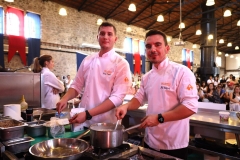
They added flavor to GURMEFEST
GURMEFEST, one of the biggest food, drink and entertainment festivals of Izmir, was ‘flavored’ with the dishes prepared and presented by the
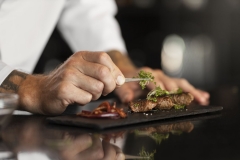
“Izmir and Bodrum will class up”
The MICHELIN Guide, one of the most prestigious restaurant rating systems in the world, has added Izmir and Bodrum to its Turkish
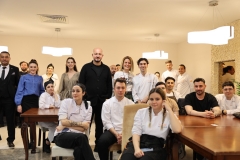
IUE graduates will prepare the flavors unique to Turkish cuisine
Bilsev Group, who is preparing to expand to Dubai this year with its Ferdi Baba, Fabrice Restaurant and Baba Pizza brands, will
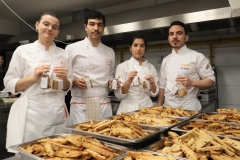
They prepared products that are filling and have a long shelf life
25 students of Department of Gastronomy and Culinary Arts of Izmir University of Economics (IUE) prepared products with a long shelf life,



